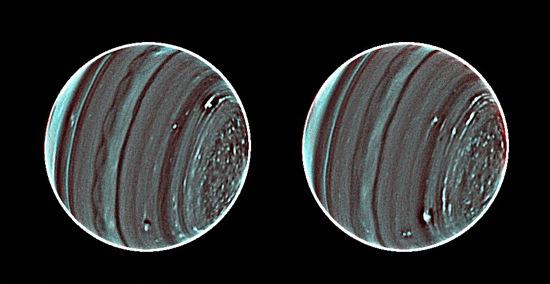Please note: Osher Rainforest will be closed for maintenance Jan. 14–16.
Science News
Friday Science Stories
October 19, 2012

Stormy weather, iron dump and tiger tourism—here are some headlines we didn’t want you to miss this week.
Weather on Uranus
Twenty-six years ago, when Voyager 2 took this image of Uranus, scientists were disappointed by the seemingly smooth surface of the distant planet. But earlier this week, astronomers displayed a wholly different picture (see right) of Uranus—sultry and stormy!
It took the Earth-based Keck Observatory to capture what Voyager 2 couldn’t, despite being only 50,000 miles from Uranus in 1986. Keck took sharp, high-resolution infrared images showing bizarre weather on the sideways planet.
The planet’s deep blue-green atmosphere is thick with hydrogen, helium and methane. Winds blow mainly east to west at speeds up to 560 miles per hour, in spite of the small amounts of energy available to drive them.
Scientists believe that the primary driving mechanism for these storms must be solar energy because there is no detectable internal energy source. “But the Sun is 900 times weaker there than on Earth because it is 30 times further from the Sun, so you don't have the same intensity of solar energy driving the system,” says planetary scientist Larry Sromovsky. That might explain why storms on Uranus are much less violent than those on Earth.
Sromovsky and colleagues announced their findings this week at a meeting of the American Astronomical Society's Division of Planetary Sciences.
What were you thinking?
That’s what we would like to ask local Russ George. This week, several news outlets report how George dumped 100 tons of iron into the Pacific Ocean off the British Columbia coast illegally.
George has a history of geoengineering attempts like this one. This time a native Canadian group hired him to reduce carbon in the ocean to boost dwindling salmon populations. If you recall from a story we ran last summer about this technique, iron can feed algal blooms, which then sink to the ocean floor, sequestering carbon as they do.
But tampering with the ocean like this is obviously dangerous and highly regulated. According to the New York Times, George dumped ten times as much iron as the experiment mentioned in our story and violated two international agreements on geoengineering.
Tigers, Detroit and otherwise
Even before Detroit finished New York off in the American League Championship Series on Thursday, talks of trading Yankee star Alex Rodriguez were rampant.
His post-season performance was so bad, he was benched for the last two games. And we all know how much the Yanks like to win. But A-Rod’s contract looks to be a losing proposition for the team—even if they are able to unload him, they’ll likely have to pick-up part of his remaining salary. Which is huge, according to ESPN,
Rodriguez, who will turn 38 next July, is signed for the next five years and guaranteed another $114 million.
In addition, his contract includes a marketing agreement with the Yankees that could add as much as $30 million to the deal…
Such a waste. If you’ll remember, a couple of years ago we discussed how his large salary could help save wild tigers. Who could use his help right about now. The Guardian reports that an Indian court lifted a ban on tourism in tiger reserves this week. Officials are hoping tourists and the tiger habitats can co-exist. Hopefully they have more luck co-existing than A-Rod and the Yankees.
Image: Lawrence Sromovsky, Pat Fry, Heidi Hammel, Imke de Pater